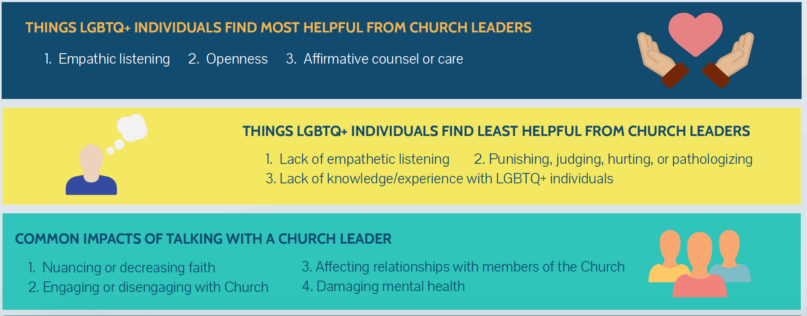
Tyler Lefevor, lead researcher. Courtesy photo
(RNS) — A new study has some tips for local leaders in the Church of Jesus Christ of Latter-day Saints: Do listen with empathy to church members who are LGBTQ+. Don’t give advice (unless requested), try to “fix” people or punish them for their sexuality or gender expression. Most of all, go into all interactions with LGBTQ+ members with an open mind, expecting to learn.
This study is a small, 25-person subset of a 10-year longitudinal study of 370 SGMs (Sexual and Gender Minorities) of Mormons and former Mormons in the U.S. Of that main group, the researchers selected 25 volunteers for in-depth follow-up interviews about their experiences with LDS leaders. The researchers purposely selected a mix of people.
“We have about half of our sample that’s currently active (in the LDS Church) and then half of our sample that’s not,” lead researcher Tyler Lefevor of Utah State University told RNS in an interview. “And then a range of the LGBTQ-plus spectrum: trans, nonbinary, gay, lesbian, bisexual and pansexual. The one aspect of diversity that was hard to find was racial/ethnic diversity. We struggled more with that because Mormons tend to be pretty white.”
Lefevor and his co-authors (Samuel J. Skidmore, a graduate student; Adlyn Perez-Figueroa, an undergraduate researcher; and Kirsten Gonzalez, faculty at University of Tennessee-Knoxville) have written up their findings and will also be presenting them locally to Church leaders, stake councils and ward councils. (If you are interested in scheduling one of these brief presentations, you can contact the researchers by following this link.)
Here are some of my main takeaways after reading the research findings.
1. SGM Church members’ most common experience was to have ecclesiastical leaders warn them not to violate church policy
This was not surprising: Nearly 9 in 10 participants said the advice they received was to avoid same-sex relationships if they were gay, or gender transitions if they were gender nonbinary.
The study authors note this kind of counsel is not terribly helpful for SGMs because they are already fully familiar with Church policies about sexuality. One pansexual respondent noted a Church leader merely gave out “pamphlets that I’d already read and was saying to do the things that I already knew.”
2. Leaders are often unprepared for these conversations
Also in the category of “not very surprising” is the fact that many bishops, stake presidents and mission presidents seem largely unprepared for conversations with SGMs about sexuality. Three-quarters of those surveyed said LDS clergy seemed out of their depth, saying they had received no training or education to guide them through conversations with members who were not heterosexual and cisgender.
In some cases, this was perceived as a positive, if the leader expressed a willingness to learn from the member (one member found it helpful when his bishop gave him the chance to tell his story by simply saying, “Explain it to me”). SGM members also gave leaders a broad latitude for not being experts — knowing they are unpaid volunteers in the Church — so long as they were interested in learning.
In other cases, the lack of training and preparation was damaging, especially if leaders relied on debunked pseudoscience to try to “fix” SGM members. One respondent says his mission president responded by asking “who molested me to turn me gay,” reflecting a mistaken belief that victims of sexual abuse will be “turned” gay.
Another story involved a stake president who packed a member off to a paid pornography addiction program when he heard the member was gay … despite the fact that this person did not use pornography. The stake president had simply assumed “gay = porn user.”
The study gives the sense that Church leaders who had accurate information and some training fared better in these conversations. But that’s probably not yet a common experience. “My bishop tried,” one gender nonbinary member told the researchers. “But I think he felt like he was drowning and didn’t know what to do.”

Study participants identified the responses they found most and least helpful from LDS Church leaders. Infographic courtesy of Tyler Lefevor.
3. Many leaders were affirming and positive
This was a pleasant surprise to see. Many members reported positive experiences, saying they had won “bishop roulette” and felt satisfied with their interactions with Church leaders.
One man’s local leader simply said, “Look, you need to acknowledge that you are gay and accept that.” And KB, a bisexual woman, said her leader “had the attitude of anything that straight couples can do, we should be able to do, too.”
4. Some leaders advised LGBTQ members to focus on their relationship with God, not their sexuality, as the most important things about themselves
It was heartening to see that, as the study put it, “some participants reported receiving counsel to focus on personal faith and testimony.” In other words, sexuality is just one part of an SGM’s life, not the whole, and members appreciated it when leaders de-emphasized sexuality and focused instead on caring for the person’s entire spiritual life. (Hello! Why is this concept so radical in 2022?!)
5. Some leaders were affirming, even protective
Here is a sampling of some of the quotes from those interviewed who had enjoyed positive experiences with their leaders. Some of these are deeply touching.
- Kam, who had a compassionate mission president: “He said, ‘You’re a great missionary, you’re a great person.’ Nothing negative came out of his mouth. He said, ‘You can go home, you can figure it out. Whatever happens, I’ll always be in your corner.’”
- Brian, whose bishop validated his gender identity: “He just asked why I wasn’t going to Elders Quorum. And I said, ‘Because at my last ward I was told not to go.’ And he said, ‘That’s preposterous. You need to go. That’s where you belong.’”
- Kate, whose bishop told other people in the Church: “Everybody back off. I’m going to protect Kate.”
- Jerry C., who said, “My bishop has been my protector and my supporter all throughout my career at church.”
6. Other leaders were punitive, removing callings and temple recommends
Other stories were not so positive. Some members reported having privileges and callings taken away. Collin, a gay man, reported the bishop stopped permitting him to work with young people. “Now I can no longer work with any youth in the church ever again, and that was something I absolutely loved. That’s why I looked forward to going to church every Sunday, so I could be with the youth.”
Sometimes, the punishment wasn’t a formal removal of privileges or fellowship as much as an informal sort of shaming. One young man said when he walked into his bishop’s office, the bishop said, “I’m just going to tell you right now that it is really stupid for you to go down that path (of being gay), and for you to do this to your mother and father.” The young man said he just sat there, stunned.
Other interactions that members rated as unhelpful or hurtful included leaders who invalidated members’ sexuality or gender identity (one woman’s bishop told her, “Oh, you’re just confused”) or who trotted out the horrible “love the sinner, hate the sin” line. Also negative: church leaders who pried into members’ sex lives with invasive personal questions.
7. Members gave high rankings to leaders who listened with compassion
One thing that seems clear from the interviews is that many SGM members don’t look to their bishops and stake presidents to “fix” their sexuality (though some reported hoping for this). Rather, what they want is to be seen and heard. Many don’t want advice at all, actually, but are seeking emotional comfort and validation.
They want to be out of the closet. As one man put it, “I felt that if the gospel of Jesus Christ is about being honest, you need to be honest with yourself. You should be honest with the people around you, whether it’s other members at church or leaders.”
Overall, the study can help Church leaders understand the perspectives of SGMs and put in place some constructive practices that can make these interactions more gospel-centered and less homophobic and transphobic.

Main research takeaways on improving interactions between LDS Church leaders and LGBTQ+ Latter-day Saints. Infographic courtesy of Tyler Lefevor.
Related content:
Why was last week’s speech on LGBT rights the ‘most difficult’ of LDS apostle Dallin Oaks’ career?
Mormon leaders reverse LGBT policy, raising the question: What is revelation?





